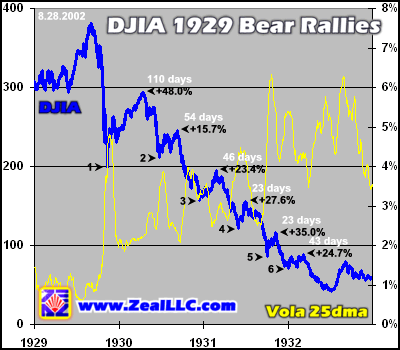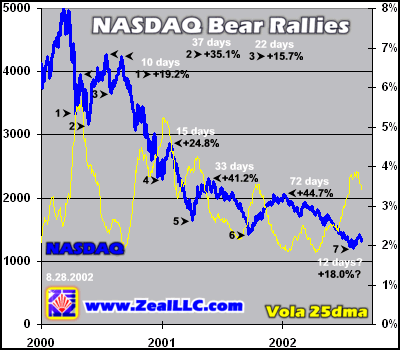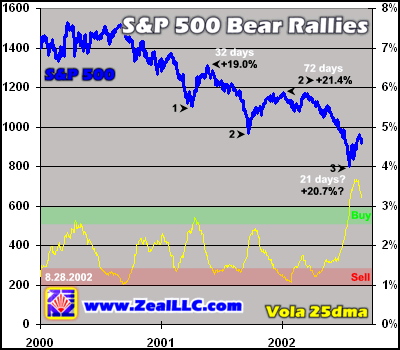|
|
|||||||
|
|
|
|
|
|
|
|
|
|
Bear Market Rallies 2 Adam Hamilton August 30, 2002 2781 Words
With the final days of unofficial summer riding off into the fiery sunset this weekend, the serious season for the equity markets is almost upon us. On September 3rd the vast majority of summer vacations for market players will fade into distant memories and it will be time to once again get down to business for autumn.
Although it constantly evolves over time, the Game of Kings for the US equity markets at this unique moment in history seems to swirl around the bear market rally that erupted in late July. Inquiring speculators want to know, even need to know, whether the current equity rally has legs or has already commenced collapsing back down into the black depths of bearish despair.
Enormous profits and losses hang on this crucial question and the late lights burn in analysts’ offices around the world trying to divine just how to play this beast. Making the right decision on the near-term market action could win fortunes while making the wrong decision could doom yet more freshly slaughtered capital to join the trillions already in money heaven since the US equity bubbles burst a couple years ago.
Back in November 2001 I wrote an essay called “Bear Market Rallies.” The thesis, quite heretical at the time, claimed that the post-9/11 rally was simply another bear market rally, that the late September 2001 lows did not mark the ultimate bottoms, and that extreme caution was in order. While it did take the post 9/11 rally longer than I originally anticipated to fail and plunge to new lower lows, the inevitable did indeed finally transpire in the summer of 2002.
Today we are in the belly of the beast of yet another seductive bear market rally. Just as last rally however, valuations remain extremely high and the primary strategic trend for US equities is still unmistakably down. Once again my partners and I believe the probability of this bear market rally ultimately collapsing to new lows is all but certain.
Regardless, we can play the markets both ways. Long or short is irrelevant, as legendary profits can be earned on both sides of the trade if blessed with good timing. In the August issue of our Zeal Intelligence newsletter, published on August 1st, we closed out all of our puts and went long with index calls expecting a bear market rally. Although controversial at the time, we were thankfully blessed with being right on that decision.
Now, with September barreling down on us like a runaway freight train, decision time is again approaching. Do we sell our index calls and buy puts again, expecting the bear market rally to soon die a grisly death? Or do we hold out for one more month, making a bet that the bear market rally has enough kinetic momentum to carry into September?
As always, making real-time trading decisions while neck deep in mud and blood in the trenches is never easy, but it must be done. We built the graphs in this essay this week to help us determine our own course of action to recommend to our clients in the upcoming September issue of our newsletter.
As we need more wisdom on what to expect in typical bear market rallies in order to compare them to the current pseudo-phoenix rally arising from the ashes of the late July carnage, it seemed appropriate to once again turn to the lessons of history and attempt to harvest some insight.
The reigning-champion ultimate textbook example of bear market rallies in history occurred after the infamous Dow 30 crash of 1929, so we begin our quest for discernment with a journey swimming back into the sands of time.
It is always a pleasure to savor this notorious Dow 30 chart pattern from 1929-1932. I suspect it is the most famous and well-known market graph in history. Virtually all students of the markets could instantly recognize and identify this pattern even if all the identifying years, index levels, and labels were sandblasted off the chart.
If only all bear market rallies played out like these! Marvel at the amazing symmetry above, a series of remarkably consistent lower lows and lower highs marking a classic supercycle bubble bust. Visually the retracements of each subsequent bear market rally look practically identical.
Mathematically they are pretty darned close too. Rallies 1-6, labeled above, had retracements of their respective preceding plunges of 52.3%, 40.5%, 42.1%, 46.2%, 44.0%, and 38.6%. The average bear market rally retracement of its preceding plunge of the DJIA 1929 bear rallies was 44.0%.
These seemingly abstract numbers are really quite important as they begin to give us an idea of what typical post-bubble bear market rally behavior looks like. We can then examine the current bear market rally of today illuminated with the bright light of past market events.
The black percentages in the graph above mark the actual percentage rallies off the interim bounce points on a closing basis. The DJIA 1929 episode had average bear market rallies of 29.1%. Each time the index reached a temporary low, a 29% bear market rally was a reasonable expectation for a short-term speculation on the long side of the playing field. If we jettison the two extreme outlying rallies, numbers 1 and 2 above, the average bear market rally ran 27.7%.
Equally important as how high each rally ran off its preceding closing low is how long it took to reach the next interim closing top, the end of each bear market rally. The time to extinction for each bear market rally is marked above in white. All six rallies above averaged 50 trading days from trough to peak. Once again if we dump the two extreme outlying percentage rallies, 1 and 2, the average DJIA 1929 bear market rally ran 34 trading days.
As there were actually short Saturday trading sessions during this early time frame in the US markets, dividing the rally trading day lifespan by six (trading days in a week) yields the number of weeks the rallies took to play out. All six rallies averaged a little over 8 weeks to run their courses, while dumping the outlying percentage rallies yields an average bear market rally run of almost 6 weeks.
In addition, we also added the 25-day moving averages of intraday volatility in each of the graphs in this essay, the light yellow lines. As I discussed in my “Trading Volatility Bottoms” essay about a month ago, these 25dma intraday vola series helped us make the tough call early that a bear market rally was upon us. In today’s essay, all the right axes off which the intraday vola 25dmas are graphed have identical vertical scales, to aid comparability across markets and eras.
Please note above how the 25dma tended to rise all throughout the DJIA 1929-1932 bust episode. Provocatively, the modern markets’ 25dmas have not exhibited this distinctive uptrend yet, an interesting divergence.
Armed with some past bear rally insights now, we know that post-bubble bear market rallies have tended to retrace about 44% of their preceding plunges, they rallied about 28%-29% off their interim bounce points, and they tended to run about 6-8 weeks before they exhausted themselves.
This knowledge gives us a solid framework and lens through which to view the current bear market rally action in the crucial NASDAQ and S&P 500 indices.
It is immediately obvious that the post-bubble NASDAQ episode lacks the dazzling symmetrical bear market rallies that marked the DJIA bust of late 1929 and the early 1930s. Nevertheless, depending on how you count your bear market rallies, which is admittedly subjective, there have been six major bear market rallies completed in the NASDAQ bust to date and we have just embarked upon our 7th this month.
The retracements of their preceding falls for NASDAQ bear market rallies 1-6 have run 36.9%, 139.9%, 93.5%, 29.2%, 55.3%, and 71.4%, respectively. The average retracement in these six major bear market rallies to date is running 71.0%, quite high. If we cut out the first three rallies from our analysis, primarily frantic reactions to the NASDAQ crash, the average retracement for the last three completed NASDAQ bear market rallies was a much more reasonable 52.0%.
As shown by the black percentages above, the average rally off the bounce points for the completed NASDAQ bear market rallies is 30.1%. If we once again cast out the first three post-crash reaction rallies, the average recent bear market rally in the NASDAQ has witnessed a 36.9% gain trough to peak.
The average NASDAQ bear market rally expiration date, if you buy groceries, or “time to live” (TTL) if you are an Internet guru, ran about 32 days. Zooming into the last three completed bear market rallies, we are looking at an average 40-day lifespan. Dividing these trading days by 5 yields an average lifespan of between 6-8 weeks per bear market rally.
If all this statistical arcania hasn’t bored you to death yet, you may remember that up above the average DJIA 1929 bear market rally also ran 6-8 weeks. In addition, the average 30% bear rally in the NASDAQ was right in line with the average 29% bear rally in the DJIA of seven decades ago. While these post-bubble busts never play out identically, they sure tend to rhyme mighty well!
Now that you have suffered through all this market trivia, here is the reason we want to understand it. The current NASDAQ bear rally, as of Wednesday August 28th, our data cutoff for this essay, managed a healthy 18% gain from closing trough to closing peak thus far, not too bad. It made this run rather rapidly, taking only 12 trading days. This data alone is meaningless of course, but in light of historical context it can be very useful for speculators trying to assign probabilities to future events.
The current NASDAQ bear market rally looks rather anemic compared to the historical precedent. To simply blossom into an average rally, it should run up between 30%-37% before it runs out of steam and noses over. We only have 18% to date. In addition, the rally would have to extend 6-8 weeks in order to transcend mere mediocrity, and it has only been galloping for about half those weeks so far. Finally, we can expect an average 52% retracement of the preceding fall but we have only witnessed 25% to date.
In light of historical precedent on post-bubble bear rallies, the current NASDAQ rally, number 7 in the graph above, has a larger probability of running higher in the next few weeks than collapsing and retesting its lows immediately, at least based on this particular analysis. Assuming it lasts seven weeks and runs up 30%, a reasonable trading target would be a NASDAQ composite close around 1560 sometime in September 2002.
Of course the short-term future is unpredictable by mere mortals like us, but odds are the current NASDAQ bear market rally hasn’t quite begun to sing its swan song yet.
One final note, it is interesting in this NASDAQ graph how the 25dma intraday volatility line has generally trended lower so far in this bust. This will probably change as the ultimate bottom on the NASDAQ draws closer, probably below 500 with current corporate earnings, but it is a peculiar anomaly now. Just as I discussed recently in “Trading Volatility Bottoms,” going long the NASDAQ when volatility is high and shorting it when volatility is low has been a very profitable strategy thus far in this ongoing bear market bust.
NASDAQ volatility also remains high at the moment, adding more weight to the continuing bear market rally hypothesis. The 25dma volatility line on the venerable S&P 500 is also currently extraordinarily high and yields similar conclusions.
Note the huge current spike in S&P 500 intraday volatility, far exceeding anything witnessed in at least the last six years. Just as with the NASDAQ, the best time to go long the S&P 500 is when volatility is high and the best time to short it is when volatility is low. With current S&P 500 volatility remaining well above the established buy level (the green band above), volatility alone would suggest the S&P 500 has not yet finished its current bear market rally.
For all you volatility enthusiasts, please realize that a 25dma lags the famous VIX by at least 13 trading days. If you want to be buying and selling within a couple days of any interim top or bottom, you have a far higher probability of achieving these short-term trading goals by watching the real-time VIX, implied volatility, rather than waiting a couple weeks to have enough data to keep the moving averages updated properly.
At this stage in the analysis the conclusion would seem cut-and-dried, right? The NASDAQ looks like it should rally higher based on past bear market rally precedent, and both the NASDAQ and S&P 500 volatility indicators remain far too high to properly signal an interim top.
Not so fast!
I personally found the S&P 500 chart the most disturbing out of all three of our graphs this week. Note that there have only been two massive bear market rallies completed in the S&P 500, probably less than the NASDAQ because the S&P 500 didn’t witness a parabolic bubble blow-off leading to a classical crash like its tech-laden brother-in-arms did. The average gain of these two earlier macro bear market rallies in the S&P 500 was 20.2%.
As the S&P 500 is much broader in the actual number of stocks it contains compared to the Dow 30 in 1929, and much broader in actual economic sectors covered than the NASDAQ in 2000, it is not surprising that the S&P 500 is not as volatile. The market capitalization of this flagship US index utterly dwarfs both the Dow 30 and the NASDAQ, partially because the S&P 500 contains the biggest and best American companies from both the other indices.
The current S&P 500 bear market rally from its July 23rd closing low of about 798 was already up 20.7% to around 963 as of August 22nd! Should we expect the S&P 500 to make a much larger gain this time around than in its past bear market rallies? Probably not, I suspect.
Throwing even more doubt about the future of today’s S&P 500 bear market rally into the seething cauldron of short-term speculation, the neckline of the S&P 500’s massive head-and-shoulders formation that just broke down in July is right around the S&P 500’s latest interim closing high of 963. In history these formations tend to follow a pattern, with the neckline evolving into strong overhead resistance once it finally fails as support in the right shoulder of the formation. A definite bearish omen!
The bottom line is this current bear market rally is throwing out seriously mixed signals. This is not too surprising though, as short-term speculation is never easy and conflicting signals are just part of the game.
The NASDAQ looks like it can rally higher based on both historical precedent and continuing high volatility. The S&P 500’s volatility numbers concur with the “few more weeks of bear market rallying” hypothesis. Unfortunately the S&P 500’s rally is already looking mature in historical percentage context and its technical behavior suggests a strong bearish headwind at its new neckline resistance level.
I truly wish I could suggest with conviction that this current bear market rally is either over or still has a few weeks left to run, but the signals are all muddled. As I write this essay I am not even sure how we are going to play September at Zeal yet. We can close our long index calls and buy some puts waiting for the bear market rally to collapse, or we can hold our calls a little longer for potentially higher profits and superior put entry prices if the bear market rally still has breath coursing through its lungs.
This weekend we are going to be working hard on the September issue of Zeal Intelligence for our dear newsletter subscribers, with a publishing ETA of September 3rd. In addition to the analysis in this essay, which is essentially a portion of the necessary research homework for the letter, there are about a half-dozen additional factors we are carefully mulling over trying to decide on our Zeal September short-term stock market speculation strategy. These factors, as well as how we ultimately decide to play these aging bear market rallies in terms of real-world trades, will be discussed in the upcoming September issue.
Thank you for humoring me by allowing us to embark upon this arcane yet enlightening statistical journey through bear market rally precedent!
Adam Hamilton, CPA August 30, 2002 Subscribe |
|||||||
|
|
|
|
|
|
|
|
|
|
|
|
|
|
|
|||



